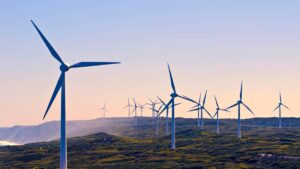POWER UP: Battery storage forecast a hint of renewables growth while oil goes meh

Growing battery storage capacity can be directly correlated with greater renewable energy adoption. Pic: RUBEN BONILLA GONZALO vis Getty Images
Evidence that the renewable energy transition is accelerating continues to grow with Queensland committing to spend up to $19bn over the next four years on renewable energy, big battery storage and long-term energy storage.
Specifically, the State Government has set aside $7bn for two state-owned pumped hydro projects whilst the six public energy providers have committed to spending just under $5.5bn on various renewable energy projects including Australia’s largest onshore wind project – the 1GW MacIntyre Wind Precinct southwest of Warwick.
This is aimed at helping Queensland achieve 70% renewable energy by 2032 and 80% by 2035.
Another sign that the adoption of renewables is picking up is Rystad Energy modelling that annual battery storage installations will surpass 400 gigawatt-hours (GWh) by 2030, a 10-fold increase from current levels.
This is noteworthy as batteries are instrumental in solving the intermittency problem of renewable energy generation.
Important, Rystad’s estimates correlate to capacity additions of about 110GW by 2030 on a power basis, almost equivalent to the peak residential power consumption for France and Germany combined.
This is generally aligned with the energy consultancy’s climate change scenario compliant with 1.9-degree Celsius carbon budget.
Rystad adds that the US Inflation Reduction Act has boosted expected solar and onshore wind capacity by 40% and the addition of more than 20GW of additional battery capacity compared to before the Act.
It also noted that China’s clean energy development will accelerate in the coming years, increasing the share of renewables in its power mix even as its average coal capacity increases have declined steadily since 2010.
Residential adoption of batteries, which currently lags the utility segment, is also expected to increase in parallel.
Oil fails to respond to Saudi production cut
While the signs are pointing towards more renewables and battery storage, crude oil prices have stubbornly remained below the US$75 per barrel mark despite Saudi Arabia’s unilateral decision earlier this month to reduce its production by a million barrels per day.
The sheer unwillingness of crude oil benchmarks such as the Brent to budge is a clear sign that investors are more concerned about the slowdown in the global economy and the fact China’s rebound after emerging from its zero-Covid policy is starting to falter.
Matters were certainly not helped by the US Energy Information Administration reporting an estimated inventory build of 7.9 million barrels for the week to June 9, though it is not clear at this stage if this is just a blip or the beginning of a sustained slowdown in consumption.
That said, it is still too early to write off oil as a has-been.
The current pricing is mostly a reflection of the poor economic sentiment and not because of any actual reduction in the underlying demand for oil.
Oil is still firmly entrenched in the modern economy and for at least the next decade or so, will still see heavy use.
Which is to say that once the global economy swings back into positive territory, you can except oil demand and pricing to climb as well.
Related Topics

UNLOCK INSIGHTS
Discover the untold stories of emerging ASX stocks.
Daily news and expert analysis, it's free to subscribe.
By proceeding, you confirm you understand that we handle personal information in accordance with our Privacy Policy.








